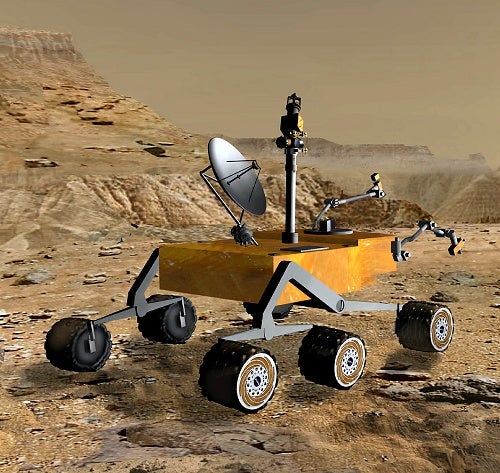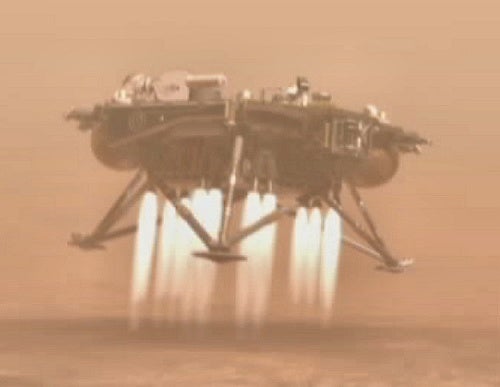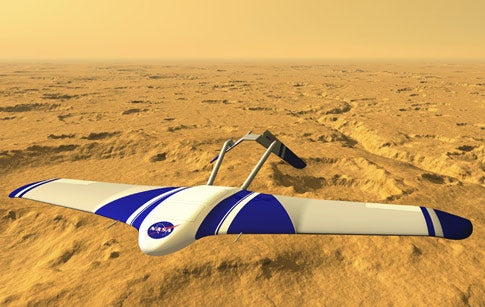Perhaps the biggest piece of news at the meeting came from NASA’s Mars Exploration program director Doug McCuistion, who described the program’s latest redesign. The adjustment is partly in response to recent scientific discoveries by American and European Mars probes, which have confirmed that Mars, during its first billion or so years, not only had a dense carbon-dioxide atmosphere but was warm enough for liquid water to exist for long periods in some places. Moreover, ground ice extends almost up to the surface in Mars’ high latitudes. The European Space Agency’s (ESA) Mars Express found tiny traces of methane in the atmosphere, a possible — if unlikely — indication of underground microbes.
But the redesign is also based on NASA’s growing funding problems. It now seems that the Mars budget will be limited to about $600 million per year. This cancels a new line of “human precursor” Mars probes announced last year. Their goal was to make environmental and engineering tests for later manned explorers.
Mars mission plans through 2011 are unchanged. In 2007, Phoenix, the first of the low-cost Mars Scout missions selected from competitive proposals by various scientific teams, will head to the Red Planet. Phoenix will land in the north polar region and study permafrost there.
Then, in 2009, comes the big Mars Science Laboratory (MSL) rover. It’s expected to drive 12 or more miles (18 kilometers) over 2 years and make the most detailed surface studies yet. These will include analyzing rock and soil samples for any traces of organic compounds.
In 2011, NASA will choose a second Mars Scout mission, but then the program changes.
In late 2013, the agency wants to launch the Mars Science and Telecom Orbiter. In part, this is a replacement for Mars Telecommunication Orbiter, a mission slated for 2009 but cancelled. The present Mars orbiters relay data from landers and rovers, but all the upcoming traffic to the Red Planet will push their capabilities. Another advisory council, the Mars Exploration Planning Group (MEPAG) recommends that its science studies focus on Mars’ atmosphere.
Indeed, at the COMPLEX meeting, Jay Bergstralh of NASA’s Langley Research Center said it’s now becoming clear that we need to be able to do at least short-term weather forecasting at Mars just to enable future landers to touch down safely and on target.
Thanks to Mars’ weak gravity and the big dust storms that heat its thin air, the density of its upper-level atmosphere fluctuates wildly. It was so much lower than expected during the entry of the Spirit Mars rover in 2004 that, had the rover opened its parachute only 3 seconds later, it would have crashed. Scientists say we also need more data on low-altitude winds. Even if they don’t cause a crash, these upper- and lower-level winds can compromise the precision landings desired for future Mars probes.
But if MSL fails to find organic compounds, NASA has a problem. The ultimate goal of the agency’s unmanned Mars program is to collect Mars surface samples and fly them back to Earth for detailed study. Because such missions will be complex, expensive, and rare, scientists want to land the first one at a spot known to possess organics.
So, in the event MSL comes up empty-handed, NASA is leaning toward flying two smaller mid-size rovers in 2016 for about the same cost as a single MSL. One alternative would be to launch a second full-size MSL. Another possibility: A stationary lander could drill down as much as 30 feet (9.1 meters) to look for organics underground. There, any organics would be protected from solar ultraviolet light and surface peroxides.
Following another Mars Scout mission in 2018, NASA’s plan for 2020 is a Network Mission. This comprises roughly half a dozen tiny landers, scattered around Mars, carrying weather sensors and seismometers.
Then, in 2022, comes the big mission — a Mars sample return. As envisioned, it would begin with a craft that would settle into Mars orbit and wait. Two years later, the actual sample-return lander and its Mars Ascent Vehicle (MAV) would blast off from Earth.
Once on the surface, the lander would either dispatch a small rover to collect samples from thousands of feet around its landing site and return them to the MAV, or trundle along the surface with the MAV on its back. Sample collection could last several months, then the MAV and a sample canister would blast off into Mars orbit and rendezvous with the waiting orbiter, which would return to Earth and drop off the samples in a small reentry capsule.
It’s a devilishly complex mission. NASA has pushed it further into the future both because of its high cost — nearly $5 billion — and because it requires at least a decade’s work on technologies needed to make it happen, like automated rendezvous. NASA, says Doug McCuistion, is interested in international collaboration but wants to make sure that it “is not on the critical path to program success.” But he also says that Mars sample return is so involved and expensive, NASA may well have to turn the mission international.
There’s been a slight change of focus, too. The first mission may deliver only about 2 pounds (0.9 kilogram) of samples, sp there’s a very good chance the it won’t turn up evidence for present or fossil life. “If you hang the Mars program on just ‘finding the bug’ and you don’t find the bug, your program is dead,” observed one COMPLEX speaker.
For this reason, NASA is defining the real goal of its Mars program as “understanding the evolution of Mars and its climate, and the degree of availability of the building blocks of life over time.” But even with the goal rephrased in this way, it’s obvious that proper exploration of the Red Planet program will take a very long time.












